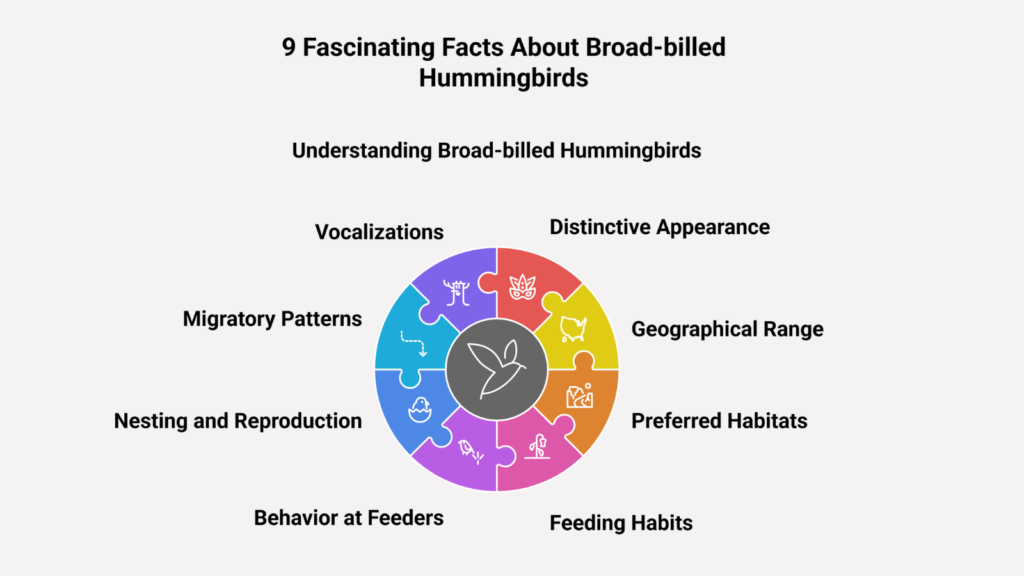The Broad-billed Hummingbird holds some of the most intriguing secrets in the bird world. From their incredible physical abilities to their surprising social behaviours, these remarkable birds continue to amaze scientists and bird enthusiasts alike.
In this article, we’ll explore nine extraordinary facts that will transform your understanding of these fascinating birds.
Key Takeaways
- Broad-billed Hummingbirds have remarkable physical abilities, including heart rates reaching 1,260 beats per minute during flight.
- These birds possess exceptional memory capabilities, remembering flower locations for up to 8 months.
- They demonstrate sophisticated behaviours, from nest-building to complex social networking with other hummingbirds.

1. Engineering Marvel: Their Specialised Bills
The broad bill that gives these hummingbirds their name is more than just distinctive – it’s a masterpiece of natural engineering. Recent studies have revealed that:
- Their bills contain specialized micro-structures
- They can extract 10% more nectar per flower visit than similar-sized hummingbirds
- This efficient feeding system gives them a significant advantage in their habitat.
2. Memory Champions of the Bird World
These hummingbirds possess remarkable cognitive abilities:
- They can remember every flower they’ve visited in their territory
- Their spatial memory lasts up to 8 months
- This exceptional memory helps them create efficient feeding routes
- They avoid wasting energy on already-visited empty flowers.
3. Record-Breaking Heart Performance
Their cardiovascular system is truly remarkable:
- Active flight heart rate: 1,260 beats per minute – among the highest in any vertebrate
- Resting heart rate during torpor: 50-180 beats per minute
- This incredible range allows them to maintain high-energy flight and conserve energy during rest.
4. Master Nest Architects
Female Broad-billed Hummingbirds showcase exceptional building skills:
- They use spider silk as elastic binding material
- Their nests can expand up to 40% of their original size
- This expandable design grows with their developing chicks
- Each nest is precisely engineered to withstand various weather conditions.
5. Hidden Ultraviolet Patterns
These hummingbirds have a secret visual language:
- Their feathers contain ultraviolet markings invisible to human eyes
- These markings are visible to other hummingbirds
- The patterns play crucial roles in:
- Mate selection
- Territorial defence
- Social communication.
6. Exceptional Hovering Abilities
Their flight capabilities surpass other hummingbirds:
- Can maintain stable hovering for up to 50 seconds
- Most hummingbirds typically hover for only 5-10 seconds
- This ability allows them to feed from flowers more effectively.
7. Temperature Control Experts
These birds demonstrate remarkable temperature regulation:
- Can drop body temperature by up to 50°F during night-time torpor
- One of few bird species capable of such extreme temperature control
- This ability helps them survive in varying climate conditions.
8. Complex Social Networks
Recent research has uncovered sophisticated social behaviour:
- Individuals recognise up to 30 other hummingbirds
- They maintain specific relationships within their community
- This behaviour was previously unknown in hummingbird species
- These social networks help them share resources and territory.
9. Climate Change Indicators
These hummingbirds serve as important environmental monitors:
- Migration patterns have shifted 15 days earlier over the past decade
- Breeding times are changing with climate variations
- These changes provide valuable data about environmental shifts.
How to Help Protect These Birds
Create Bird-Friendly Gardens
- Plant native tubular flowers
- Maintain year-round blooming gardens
- Avoid using pesticides
- Install proper feeders
- Provide clean water sources.
Participate in Citizen Science
- Report bird sightings
- Monitor local populations
- Join research projects
- Share observations with scientific communities.
Observation Tips
Best Practices for Viewing
- Time your observations for dawn and dusk
- Visit during spring and summer
- Use binoculars with close-focus capability
- For photography, use high shutter speeds (1/2000 sec minimum).
Conservation Status
Current Challenges
- Habitat loss from urban development
- Climate change impacts
- Competition for resources
- However, populations remain stable in most areas thanks to conservation efforts.
Final Thoughts
These nine fascinating facts about Broad-billed Hummingbirds demonstrate just how remarkable these tiny birds are. From their incredible physical abilities to their complex social lives, they continue to surprise and delight scientists and bird enthusiasts alike.
By understanding and appreciating these unique characteristics, we can better protect and preserve these extraordinary birds for future generations.
Have you observed any of these fascinating behaviours in Broad-billed Hummingbirds? Share your experiences in the comments below.
Frequently Asked Questions – Broad-billed Hummingbirds FAQ
Q: How can I best observe these hummingbirds’ hovering behaviour?
A: Watch them during early morning or late evening hours when they’re most active. Use binoculars with close focus capability and position yourself near flowering plants they frequently visit.
Q: Why do they use spider silk in their nests?
A: Spider silk provides elasticity, allowing the nest to expand as chicks grow. It’s also incredibly strong and helps bind other nesting materials together.
Q: How can I participate in hummingbird citizen science projects?
A: Join established programmes through local bird-watching organisations, use bird tracking apps, or participate in annual bird counts. Many scientific institutions welcome volunteer observers.
Q: What’s the best way to create a hummingbird-friendly garden?
A: Plant native tubular flowers, maintain year-round blooming plants, provide clean water sources, and avoid using pesticides. Consider installing proper hummingbird feeders with a 4:1 water-to-sugar ratio.
Q: How do these hummingbirds survive cold nights?
A: They enter a state called torpor, where they can lower their body temperature by up to 50°F and reduce their heart rate to conserve energy during cold nights.
